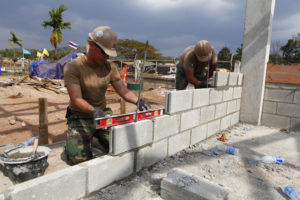Why It Matters: Equations and Inequalities
How do Equations and Inequalities Help in the Real World?
 U.S. Navy Seabees help build a classroom for a school in Thailand.
U.S. Navy Seabees help build a classroom for a school in Thailand.[latex]Area=\left(length\right)\times\left(width\right)=\left(x+100\right)\left(x\right)=x^2+100x[/latex]
Now since the total area must be equal to 12,000, we can write:[latex]x^2+100x=12,000[/latex]
or equivalently,[latex]x^2+100x-12,000=0[/latex]
This is an equation, which is a mathematical statement consisting of two expressions set equal to one another. In order to find out the proper length and width of the floor, we would have to solve the equation for the variable x using techniques that you will soon discover. Suppose the walls of the school will be built from concrete blocks costing $1.20 per block (which includes tax) plus a flat fee of $100 for hauling the blocks to the site. Having only a limited budget, you must be very careful to order only what you can afford. Suppose the school requires at least 1800 concrete blocks (but having more blocks around for future projects would not be a bad idea). Your budgeted amount for concrete blocks is $2,400. What is the maximum number of concrete blocks that you can purchase? Do you have enough money to buy at least the minimum number of concrete blocks required for the project? To answer the question above, we must be familiar with inequalities. An inequality is a statement involving relations like “less than,” “more than,” “at least,” or “at most.” For example, if the number of blocks to be purchased is n, then there are two inequalities implied by the story.[latex]n\ge1800[/latex] and [latex](1.20)n+100\le2400[/latex]
The first inequality expresses the fact that at least 1800 blocks are required. The second inequality states that the total cost of the blocks, together with the hauling fee, cannot exceed the budgeted amount of $2,400. In this module, you will learn how to analyze this situation as well as many others that involve building and solving equations and inequalities. We will revisit our construction site again at the end of the module.Learning Outcomes
Review Topics for Success- Solve rational equations
- Recognize formulas for perimeter, area, and volume.
- Recognize the formula that relates distance, rate, and time.
- Rearrange formulas to isolate specific variables.
- Represent inequalities using an inequality symbol.
- Represent inequalities on a number line.
Linear Equations
- Solve equations in one variable algebraically.
- Solve rational equations.
Models and Applications
- Write a linear equation to express the relationship between unknown quantities.
- Write a linear equation that models two different cell phone packages.
- Use a linear model to answer questions.
- Set up a linear equation involving distance, rate, and time.
- Find the dimensions of a rectangle given the area.
- Find the dimensions of a box given information about its side lengths.
Quadratic Equations
- Factor a quadratic equation to solve it.
- Use the square root property to solve a quadratic equation.
- Use the Pythagorean Theorem and the square root property to find the unknown length of the side of a right triangle.
- Complete the square to solve a quadratic equation.
- Use the quadratic formula to solve a quadratic equation.
- Use the discriminant to determine the number and type of solutions to a quadratic equation.
Equation-Solving Techniques
- Solve a radical equation, identify extraneous solution.
- Solve an equation with rational exponents.
- Solve polynomial equations.
- Solve absolute value equations.
Linear Inequalities and Absolute Value Inequalities
- Use interval notation to express inequalities.
- Use properties of inequalities.
- Solve compound inequalities.
- Solve absolute value inequalities.
Licenses & Attributions
CC licensed content, Original
- Why it Matters: Equations and Inequalities. Authored by: Lumen Learning. License: CC BY: Attribution.
- Revision and Adaptation. Provided by: Lumen Learning License: CC BY: Attribution.
CC licensed content, Shared previously
- US Navy Seabees build a classroom in Thailand. Authored by: U.S. Marine Corps photo by Lance Cpl. Alejandro Pena. License: Public Domain: No Known Copyright.
